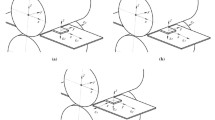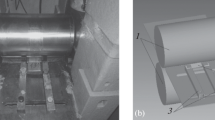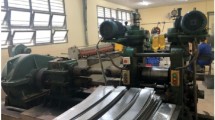We developed a software system for the numerical analysis and design of the technological modes of continuous rolling of copper and brass strips, which enables us to investigate and design the conditions of deformation required to form specified transverse deviations of the thickness of rolled products. We refined the regularities of the influence of various lubricants and the models of distribution of tangential stresses along the contact arc (according to Coulomb and Zibel) on the pressure, rolling forces, and transverse profiles of the strips of L63 brass. We give recommendations concerning the technological mode and contouring of the rolls in a Tandem-1000 continuous three-stand rolling mill-1000 at the Kirov Nonferrous Metals Processing Plant with an aim to reduce transverse deviations of the thickness of thin strips of L63 brass.


Similar content being viewed by others
References
R. L. Shatalov, A. S. Lukash, and V. M. Lugovskoi, “Computer simulation and design of the continuous rolling process of strips,” in: Proc. Int. Sci.-Pract. Conf. Innovative Technologies of Plastic Working of Metals, NITU MISiS, Moscow (2001), pp. 232–236.
P. I. Polukhin, G. Ya. Gun, and A. M. Galkin, Resistance of Metals and Alloys to Plastic Deformation: Handbook, Metallurgiya, Moscow (1983).
A. V. Zinov’ev, A. I. Kolpashnikov, P. I. Polukhin, et al., Technology of Plastic Working of Nonferrous Metals and Alloys: Textbook, Metallurgiya, Moscow (1992).
A. A. Bogatov, Mechanical Properties and Models of Fracture of the Metals, UGTU-UPI, Ekaterinburg (2002).
R. L. Shatalov, A. S. Lukash, and Yu. F. Timin, “Creation and investigation of a microprocessor system of control over the rolling forces in a two-roll sheet mill,” Metallurg, No. 10, 70–73 (2015).
R. L. Shatalov, A. S. Lukash, and V. L. Zisel’man, “Determination of the mechanical properties of copper and brass strips according to the parameters of hardness in cold rolling,” Tsvet. Met., No. 5, 61–65 (2014).
A. I. Tselikov, P. I. Polukhin, V. M. Grebenik, et al., Machines and Units of Metallurgical Works, Vol. 3, Machines and Units for the Production and Finishing of Rolled Products, Metallurgiya, Moscow (1988).
A. A. Korolev, Design and Numerical Analyses of Machines and Mechanisms of Rolling Mills, Metallurgiya, Moscow (1985).
A. P. Grudev, External Friction in Rolling, Metallurgiya, Moscow (1973).
Yu. D. Zheleznov, S. L. Kotsar’, and A. G. Abiev, Statistical Investigations of the Accuracy of Sheet Rolling (1974).
T-Mike EM Ultrasonic Material Thickness Gauge: StressTel Manual (2007).
Author information
Authors and Affiliations
Corresponding author
Additional information
Translated from Metallurg, No. 11, pp. 71–76, November, 2017.
Rights and permissions
About this article
Cite this article
Shatalov, R.L., Lukash, A.S., Zaikin, A.M. et al. Investigation and Computer Design of the Technological Modes of Continuous Rolling of Thin Brass Strips with Specified Accuracy. Metallurgist 61, 994–1000 (2018). https://doi.org/10.1007/s11015-018-0598-x
Received:
Published:
Issue Date:
DOI: https://doi.org/10.1007/s11015-018-0598-x




